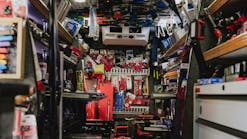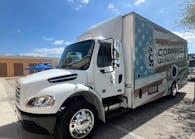Blog: 5 tips for customizing your tool truck
Tool trucks play an important role in the distribution, rental, and sales of a variety of products. For those who are investing in a tool truck, there are many considerations to make. From the size of the tool truck chassis to the extras included in the layout, the process involves careful consideration of how the truck will be used and how to create the best efficiencies for everyone involved.
The following tips will help as you go through the design process, ensuring that every need you have is met.
1. Consider slide-outs
Accessing tools is much simpler when the right design for shelving and drawers is implemented. One highly effective customization for tool trucks is the addition of heavy duty slide-outs. There are two main ways slide-outs can be implemented into the design of the build.
To allow for floor-level shelving to quickly be pulled out: Slide-outs can make it simple to keep tools out of the way when they are not needed while making it far easier to access low-level drawers and shelving than a traditional box-style build.
To allow for exterior drawer access: In some cases, a tool truck’s main design focus will be on the exterior of the build. Slide-outs can be extremely helpful in making it efficient and simple to access tools that are tucked away when the vehicle is in motion.
2. Create flexible shelving
In many cases, a tool truck will serve multiple purposes. One day, it might house thousands of tools and be turned into a mobile retail store. On other days, it might be used to make visits to businesses for tool rentals, carrying only a few hundred tools at a time.
This is where flexible shelving can improve the function of the truck. These shelves can quickly be swapped in and out of the tool truck, reducing the load being carried when the tools aren’t needed.
Flexible shelving can also make it easy to set up at trade shows or other events. Simply snap the shelving out and set it up in another location. Flexible shelving is a great pick for those who use their tool truck for sales and onsite visits.
3. Opt for subtle brand touches
One unique way to create a tool truck that stands out to clients is to implement subtle branding touches. Rather than simply wrapping the tool truck with your brand and logo and calling it done, look for other places where your name can be showcased.
For example, custom die cuts of your logo can be implemented into drawers and cabinets. Seats can be embroidered with logos. Built-in monitors can be used to display company info. The sky’s the limit when it comes to adding your own brand and style into the build.
4. Add in tool-specific displays
Whether your tool truck is used for sales, rentals, or transportation, it can be helpful to build tool-specific displays and storage space into the truck. For example, rather than tossing your sockets into a drawer, consider creating a custom drawer where sockets can be stored in spaces designed for each specific socket size.
Tool-specific displays can also help keep your retail space clutter-free, helping to keep clients focused on the tools for sale.
5. Keep functionality at the center of the floor layout
There is a lot that can be built into a tool truck. The key to ensuring that the tool truck works well for the job at hand is to always keep functionality at the center of the design of the layout.
Make sure that as you work with a designer, you mentally walk through the space. If a sales team member will be using the tool truck, bring them into the conversation and ask for any input on the most efficient workflow possible.
For example, if the tool truck will be used as a mobile store, make sure you think about where customers will enter and where a sales staff member will be located while helping them shop. Think through the checkout process and make sure you won’t be blocking other shoppers.
Information provided by Summit Bodyworks


